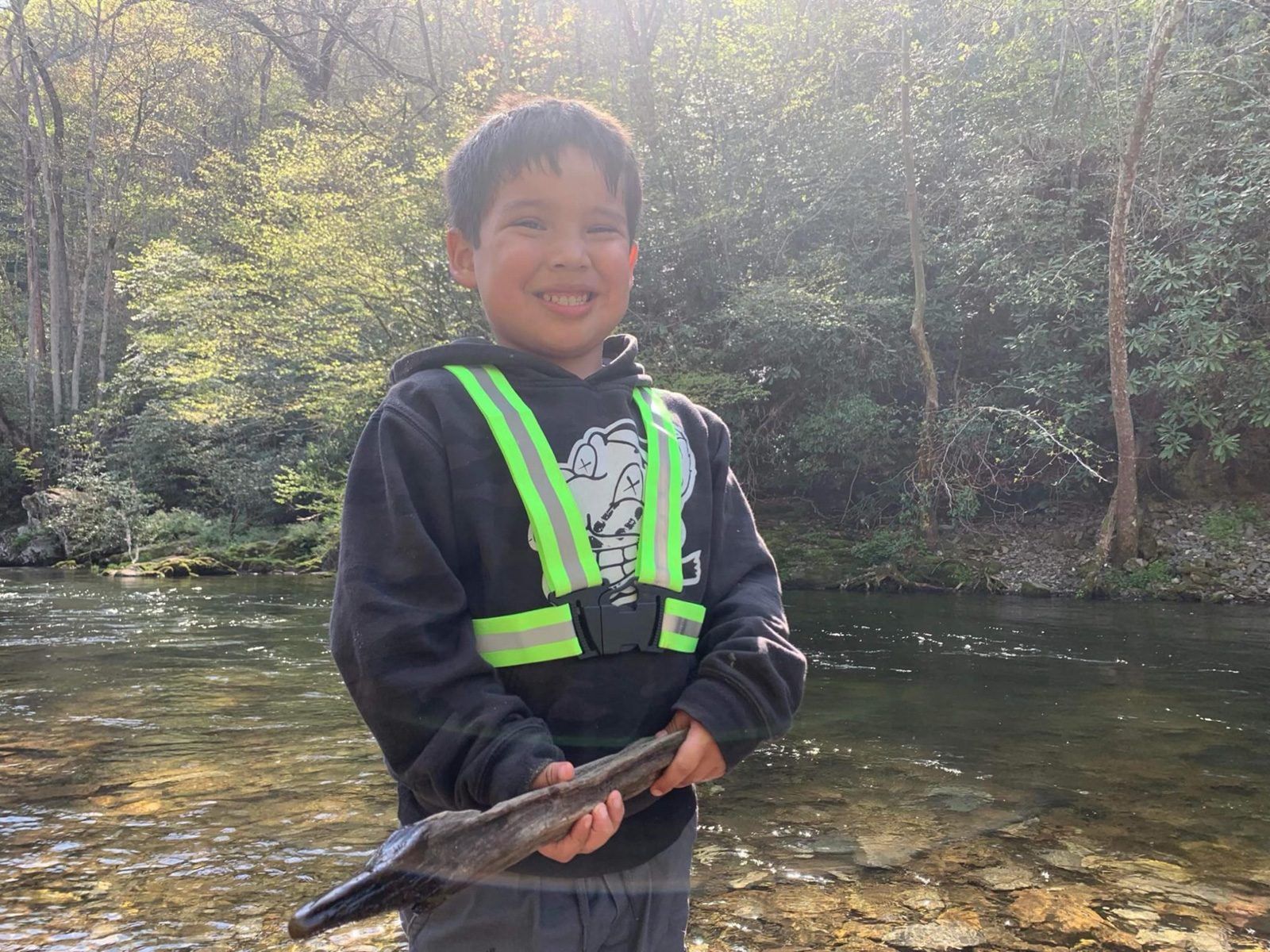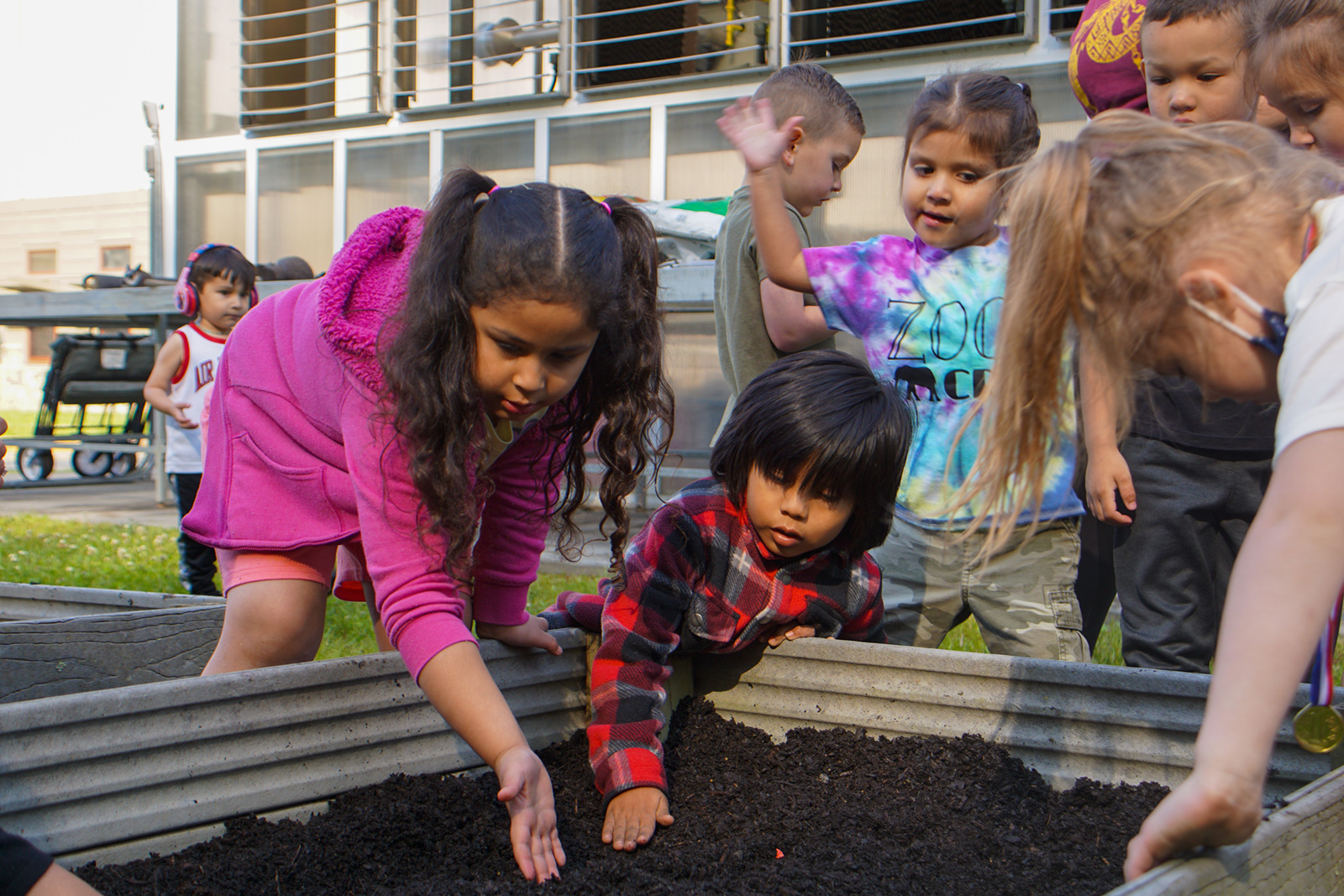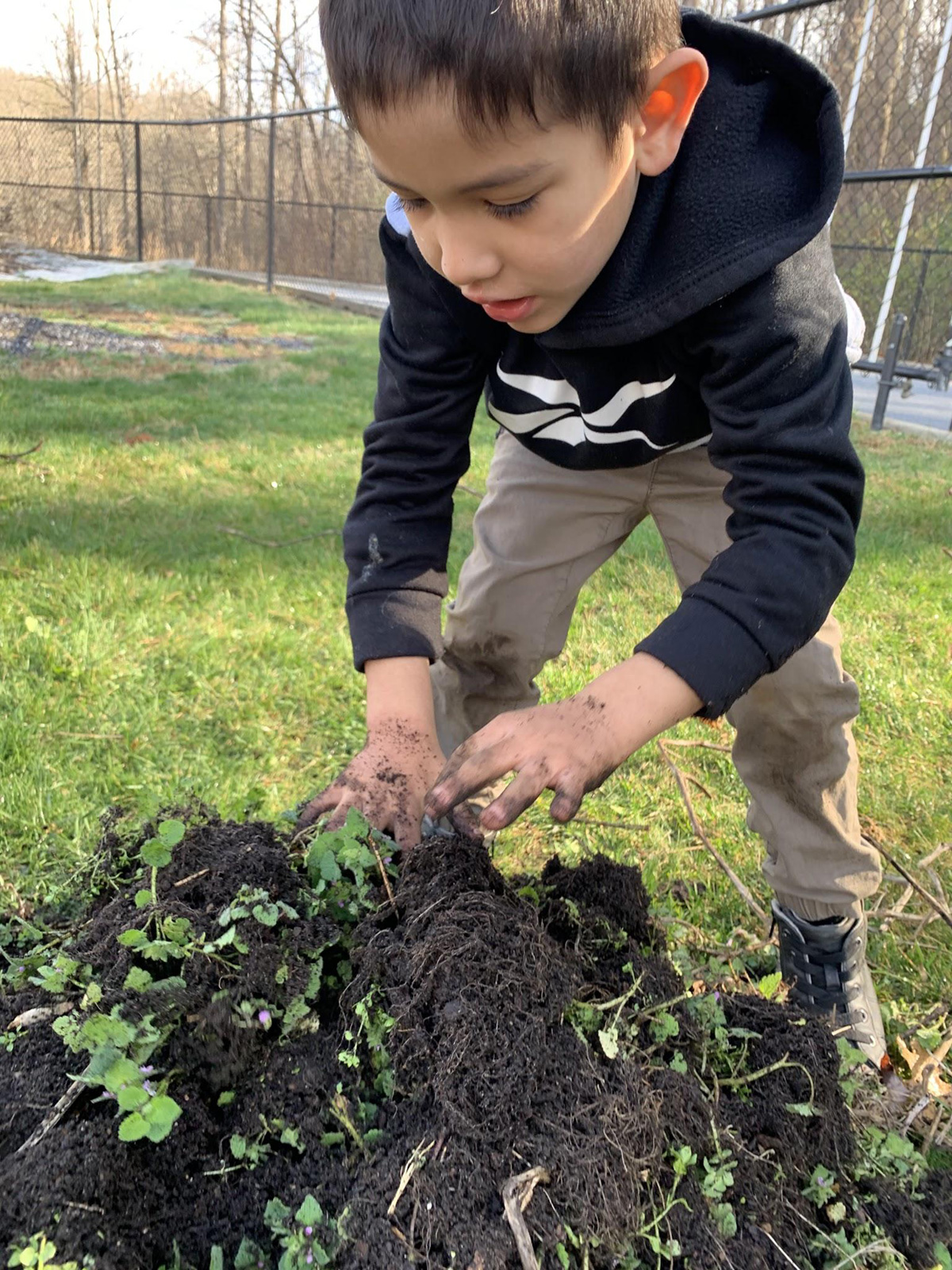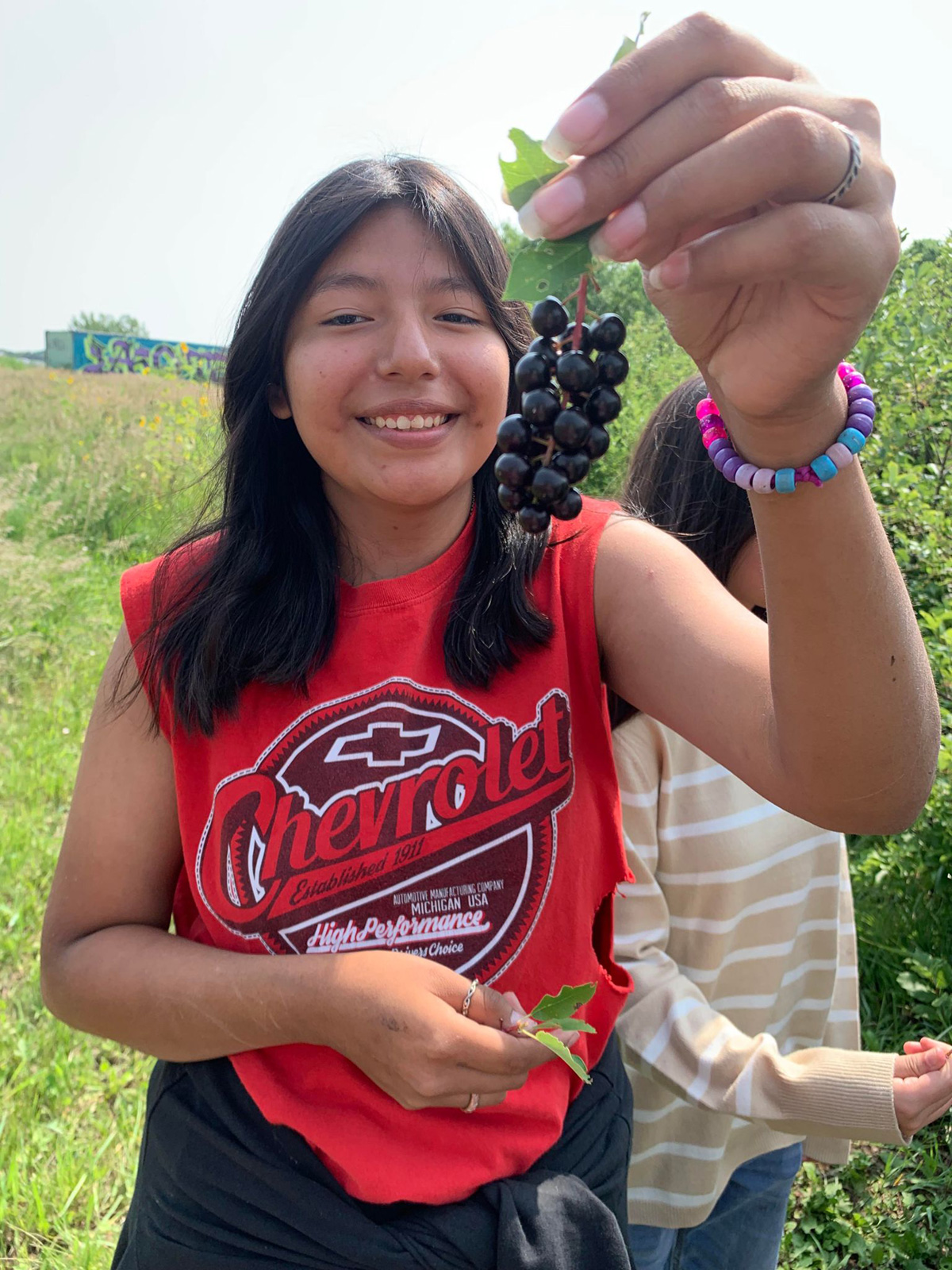Every weekday morning, Nichole Efird greets her students with a hug and the promise of another adventure. With a curriculum that leans heavily into farming, gardening and learning about the natural world, each day brings new wonders and excitement for her four- and five-year-old charges at the Cherokee Elementary School on the reservation of the Eastern Band of Cherokee Indians (EBCI) in North Carolina.
For Efird, teaching pre-K farming and gardening is about more than planting a seed and watching it sprout into a vegetable, she says. It’s about the reclamation and preservation of the ancient foodways of the Cherokee by promoting and instilling their traditional ways among their youngest members.
“This is a year-round program where we’re teaching them about their connection to the earth using our traditional foods, our language, our culture and our creation stories,” says Efird, who began teaching preschool in 2013. “We explore the life cycle and relationship of corn, beans and squash, which we call the Three Sisters, as well as how we find and use our traditional plants, nuts, seeds and berries. They are always beyond excited to get outside and get their hands in the dirt.”
As the kids learn how to sow, water, weed and track how their plants are growing, they also have units about tadpoles, weather patterns, fish, fowl, trees, water quality and a host of other STEM subjects throughout the year.

“I absolutely love our class because they truly want to know how things work and it’s fueled their love for the outdoors and is teaching them about who they are as the future stewards of our lands,” says Efird. “It’s outdoors, it’s collaborative and it promotes healthy communication while they’re brainstorming how to do something or solve a problem. They’ve committed their hearts to it and they’re invested all the way.”
Efird and her preschool class are not a one-off educational experiment. EBCI’s early childhood food sovereignty initiative is part of a growing national trend among America’s Indian tribes—many of whom have been designated by the government as “food deserts”— to reclaim their traditional agricultural heritage and improve health disparities that have plagued Native people since the beginning of colonization.
Centuries after pandemics, forced removals to unfamiliar, inarable lands and the intentional destruction of their food systems, tribes from Alaska to Maine are building massive farm operations with traditional Indigenous crops using both ancient and modern technologies to grow their own food. Moreover, they’re investing in bison herds, stocking fisheries, restoring salmon runs and habitats like wild rice beds as a way to ensure their food security in the 21st century and beyond.
“We learned the hard way during the pandemic that access to food can be a huge problem if you’re not prepared,” says Efird. “Store shelves were empty, and that was a big eye-opener.”
Thus, Efird and her students, whom she calls “my babies,” represent a return to what makes Indigenous people so unique in their relationship to the Western Hemisphere and their contributions to the world’s food heritage.
How Indigenous Americans Fed the World
Since the time of our ancient human ancestors, access to nutrient-rich food has been an ongoing project throughout history. Whether foraged, hunted, fished or selectively cultivated through managed husbandry, food has played a central role in human development, fueling the growth and expansion of the most dominant species on the planet.
In the plant and animal kingdoms—from insects to whales, from algae to the tallest trees—nothing edible was off limits in pursuit of human survival.

Starting around 12,000 years ago, human societies around the globe independently began domesticating livestock, cultivating crops and preserving and storing food surpluses as a way to ensure their survival in the event of scarcity brought on by drought, flood, wildfire, volcanic activity, war or other unforeseen calamities. Farming and husbandry was a kind of insurance policy against the myriad ways food sources can disappear virtually overnight.
Indigenous peoples of the Americas were no different, and, in fact, were global leaders in the areas of genetics and selective breeding of both plants and animals that were domesticated and cultivated throughout the Western Hemisphere, which was a biodiverse paradise prior to Columbus.
In a variety of radically different climates and terrains, from the frozen Canadian north to the tip of southern Chile, Indigenous peoples of the Americas experimented and developed hundreds of plant species and varietals from their wild cousins, including corn, beans, squash, tomatoes, sunflowers, peppers, peanuts, chocolate, avocados, potatoes, pineapples, strawberries, quinoa and vanilla—to name just a few.
Selective breeding and plant genetics by the Incas, for example, were in use thousands of years before Gregor Mendel was credited for “discovering” the rules of genetics in the 1800s. Their ancient terraced gardens high in the Andes (at approximately 10,000 ft. above sea level) are studied by global scientists to this day to better understand the origins of their plant husbandry and ability to maximize their land and limited water supply to feed roughly 12 million people in their empire.
“Indigenous agriculture in the Americas had very sophisticated farming and irrigation techniques based on the ancient, intrinsic knowledge of their environments,” says Jasmine Locklear, a member of the Lumbee Tribe of North Carolina and Agriculture Education and Special Projects Coordinator for the Tribal Agriculture Fellowship (TAF). “From time immemorial, our ancestors engaged in regenerative agriculture with long-term, generational management and were able to thrive because they adapted as needed.”
Soon after Columbus arrived in 1492, Indigenous-cultivated fruits, vegetables and grains began spreading rapidly during the Age of Discovery, bringing diversity—and much-needed nutrients—to the rest of the world. The introduction of corn and potatoes alone, for example, which are high in vitamins, minerals, micronutrients and fats, drove down infant mortality rates and nutritional diseases like scurvy and rickets that had plagued European populations for centuries.
Moreover, they provided two to four times more calories per acre, and came ready-to-eat, without the extra processing required for wheat, barley, oats and other grains. Surpluses were also fed to livestock, which led to a higher yield of protein.
Hence, overall food supplies became more productive and reliable—which brought about one of the largest population explosions in history, ultimately leading to the largest mass migration in human history. According to historian David Eltis, nearly 50 million people left Europe for the Americas in the 1800s alone.
By feeding the world, Indigenous agriculture had succeeded far beyond anyone’s wildest imagination. But the people who developed these food sources over thousands of years would soon become the unwitting victims of their own success.
For Locklear and thousands of Indigenous farmers across the continent who are reclaiming and continuing the traditional foodways of their forebears, however, the recognition of those who developed many of the world’s food staples is long overdue. Today, over 60 percent of the world’s food originated in the Americas.
“I think our agricultural heritage truly shows the magnificence of Indigenous scientific achievements,” says Locklear. “We are reclaiming and acknowledging the work of the ancestors and their contributions to the world as we engage in food sovereignty to feed our people in the 21st century and beyond.”

The Politics of Food
As the rest of the world was benefiting from a higher standard of living through better nutrition, tribes throughout the Western Hemisphere were concurrently experiencing the immediate effects of migration and colonization. The new inhabitants brought infectious diseases and invasive plants, animals, trees and weeds that either killed off or substantially reshaped the entire ecological, biological and social environments of the Americas.
In relatively short order, an estimated 56 million Indigenous people perished from the scourge of foreign pathogens like smallpox, measles and typhus—so rapid and catastrophic that the conquistadors recorded the massive scale of death in their journals. This led to the abandonment of vast farmlands, after which food shortages and famine became common for the survivors, many of whom were orphans.
And though horses (which were originally indigenous to North America) proved useful and even essential to the tribes, European animals, including cows, pigs, goats and sheep, destroyed ancient habitats as they grazed their way through the continent chewing up vast swathes of grasslands and vegetation. Indigenous crops and plants used for medicines were dug up and replaced by invasive species and monoculture foreign cash crops like sugar and coffee, which led directly to the need for slave labor from Africa to work the land.
By the 1800s, as the U.S. Government began to grapple with its “Indian problem,” in regard to western expansion, Indigenous food systems became targets in the quest to eradicate the tribes. The U.S. Army engaged in numerous scorched-earth campaigns razing villages, stored food, ancient orchards and croplands, destroying food systems and cutting off access to water as a weapon of war in order to open up land for new settlements.

As rail expansion continued West into the Northern Plains and beyond, the iconic American Buffalo, which numbered in the tens of million and covered vast areas from Alaska to the Eastern Seaboard, was targeted for destruction by the U.S. Government to eliminate the food supply upon which many tribes had depended for millenia.
By the late 1880s, approximately 60 million buffalo had been hunted and slaughtered to near-extinction, leaving only a few hundred survivors, thus creating famine and food shortages among tribes throughout the entire western United States.
Shortly thereafter, tribes were coerced into giving up their lands and pushed onto reservations, where they were prohibited from gardening, hunting, fishing or gathering food, thereby forced to subsist on limited and unhealthy government rations to survive. Overnight, their diet had switched from whole foods and quality proteins to lard, salt and sugar ultra-processed junk, which was often moldy or contained bugs.
Thus began the long, painful decline in Native American health outcomes. Ever since, American Indians and Alaska Natives have continued to suffer from some of the highest health disparities in the entire world, including but not limited to: Heart disease, diabetes, cancer, gall bladder and dental disease, as well as high maternal and infant mortality rates across all tribes.
“That’s why these education initiatives are so important to Native kids,” says Locklear. “They may not necessarily go into agriculture as a career, but I can guarantee you they will advocate for tribal agriculture for the rest of their lives. That is the depth of the work we are doing—catching them young and teaching them to touch the dirt in the same way that my family has touched for thousands of years. Because that’s who we are as Indigenous people.”
The Good Earth
In the Fall of 1999, Julie Garreau had an epiphany. As CEO of the non-profit Cheyenne River Youth Project (CRYP), she stood in the middle of a recently donated community garden plot on the Cheyenne River Indian Reservation in Eagle Butte, South Dakota. Taking stock of its possibilities, she immediately understood the potential for impacting the people who needed it most: The tribe’s children.
Founded by Garreau in 1988 to offer afterschool homework assistance, sports, activities, snacks and mentorship to Lakota youth, CRYP had been given responsibility for the two and a half-acre community plot after its elder caretakers began passing on.
The Winyan Toka Win Garden (which means “Leading Lady” in Lakota), was named for Garreau’s mother, Iyonne, who was the executive director of the tribe’s elder program and the garden. Now, it was up to the youth to continue the important work started by elders who had carefully managed and cultivated the garden for decades.
“My goal at first wasn’t necessarily to grow food,” says Garreau. “Because I could see that the kids in our community had lost their connection to the earth and had not grown up with home gardens as my generation had and it was really apparent. They had no idea where their food came from.”

Moreover, she says, they had become accustomed to the low-nutrition, ultra processed foods that are common on many remote Indian reservations due to lack of access to quality fruits, vegetables and proteins. So rather than begin with a production approach, Garreau says she instead wanted to make it kid-friendly, using the garden as a teaching tool to reintroduce them to the joys (and hard work) of growing food for themselves and their community.
“I wanted to get them outside and get their hands in the dirt and interact with the ecosystem first,” says Garreau. “Because we know that gardening and dirt does something to your body. It reduces stress, boosts your mood and lowers anxiety. That was frankly more important in the beginning given the challenges some of these kids face.”
Over the past 25 years, Winyan Toka Win has been tended by hundreds of children, teenagers, volunteers and staffers, who work each year to maximize the short, 40-day growing season in South Dakota’s harsh climate. Garreau also taught herself canning, freeze drying and preserving so that she could teach the kids and community members how to preserve their own food at home.
“We just had a pandemic, which was very difficult for Native communities in terms of access to quality food,” says Garreau. “So it’s going to be absolutely necessary going forward that you need to learn to grow your own food. It’s going to be essential for all tribes in order to survive—and we’re survivors.”
Now growing up to 10,000 pounds of organic, pesticide-free fruits and vegetables each year, Winyan Toka Win has become a national leader in teaching gardening and traditional Indigenous foodways to Lakota children as a way to reconnect them to the healing power of the earth. Produce from the garden is also used for healthy meals and snacks for the afterschool programs, as well as operating the weekly CRYP Farmer’s Market open to the community every summer.
But it was a recent hire that makes her proud of the work at Winyan Toka Win.
“We just hired one of our former youth interns as our full-time gardener,” says Garreau. “It was a lovely, full-circle moment where one of the kids that we mentored is now managing our garden. That’s exactly why we started this initiative—to grow our own, who can now take it and continue its journey.”

Suzette Brewer
Suzette Brewer is a writer and producer specializing in federal Indian law and social justice issues, having written extensively on Indian Child Welfare, the Supreme Court, violence against Native women, education and environmental issues on Indian reservations.
She has written for National Geographic, The Dallas Morning News, The Denver Post, Scripps News and many others. Her published books include Real Indians: Portraits of Contemporary Native Americans and America's Tribal Colleges; and Sovereign: An Oral History of Indian Gaming in America.
She is the 2015 recipient of the Richard LaCourse-Gannett Foundation Al Neuharth Investigative Journalism Award for her work on the Indian Child Welfare Act; a 2018 John Jay/Tow Juvenile Justice Reporting Fellow for reporting on juvenile justice in Indian Country; and a 2020 recipient of the Robert F. Kennedy Human Rights Grand Prize for the documentary A Broken Trust for Scripps News Service. She is a member of the Cherokee Nation and is from Stilwell, Oklahoma.


